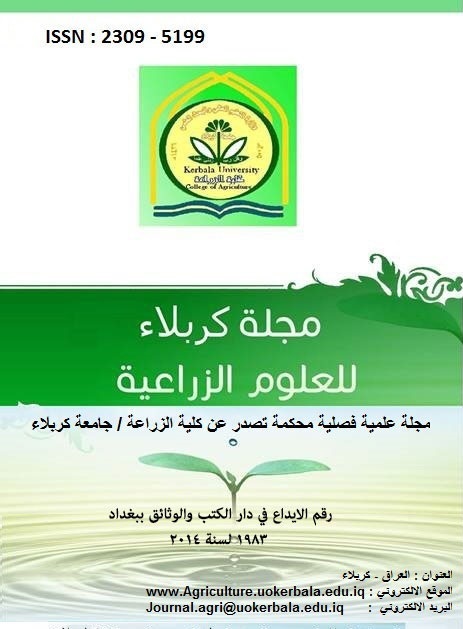Response of olive seedlings for treatment with licorice and yeast extract
DOI:
https://doi.org/10.59658/jkas.v4i4.255Keywords:
licorice , yeast , olive seedlingAbstract
This search was conducted in the lath of the Department of Horticulture and landscape – College of Agriculture / Kerbala University for the summer season 2016 on olive seedlings Khadairytype (high Syrian oil type) to see the effect of treatment with licorice and yeast extracts in the growth and development of olive seedlings ; 27 olive seedlings with one year old planted in mixed in 5-kg perforated polyethylene bags were divided into three groups of three replicates and treated with three levels of licorice and yeast extracts (0, 4 and 8) g.L-1.
A 3 × 3 experiment was carried out with (R.C.B.D). The results of the statistical analysis showed that the treatment with licorice was 8 g. L-1 was significant in both the number of leaves , respectively, while the treatment of licorice was 4 g. L -1 in the height of the plant by giving the highest rate, while the treatment of licorice (comparison) was 0 g. L-1 and the rest of the treatments in both stem diameter, dry and dry weight of the root mass respectively, while the yeast extract showed a concentration exceeding 4 g. L-1 on the rest of the treatments (plant height, stem diameter, wet and dry weight of total Vegetative and dry weight of the root total) sequentially. The treatment with yeast extract did not have any significant effect on the number of leaves and the area of the leave.
The interaction between the study coefficients also showed a significant effect on the different concentrations in all the studied traits, which in turn led to a positive effect of these treatments on the olive seedlings, which led to increased activity and stimulating growth for these seedlings throughout the research period.
Downloads
Published
How to Cite
Issue
Section
License
Copyright (c) 2017 Copyright (c) 2024 is the Author's article. Published by the Journal of Kerbala for Agricultural Sciences under a CC BY 4.0 license

This work is licensed under a Creative Commons Attribution 4.0 International License.
Licensing Terms
All articles are published under a Creative Commons License and will be directed to the Creative Commons Attribution 4.0 International License (CC BY 4.0) That permits use, distribution, and reproduction in any medium, provided the original work is properly cited. This license also allows the work to be used for commercial purposes.
Use by both non-commercial and commercial users
This content is licensed under a Creative Commons Attribution 4.0 International (CC BY 4.0) license, permitting use by both non-commercial and commercial users. Individual users may access, download, copy, display, and redistribute the articles to colleagues, as well as adapt, translate, and text- and data-mine the content, subject to the following conditions:
- The author's moral rights, including the right of attribution and the right to protect their work from derogatory treatment, are respected.
- Where content in the article is identified as belonging to a third party, users must ensure that any reuse complies with the copyright policies of the owner of that content.
- If the article content is reused for research or educational purposes, users should maintain a link to the appropriate bibliographic citation, including the DOI and a link to the published version on the journal's website.

